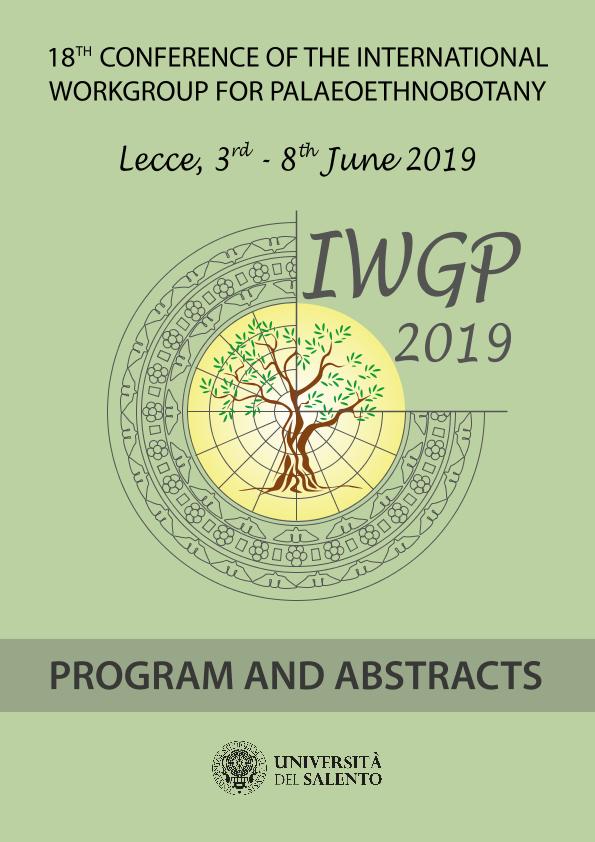Mostrar el registro sencillo del ítem
dc.contributor.author
Ciampagna, María Laura

dc.contributor.author
Molares, Soledad

dc.contributor.author
Ladio, Ana Haydee

dc.contributor.author
Capparelli, Aylen

dc.contributor.other
Fiorentino, Girolamo
dc.contributor.other
Primavera, Milena
dc.date.available
2021-07-27T15:20:11Z
dc.date.issued
2019
dc.identifier.citation
Starch grains description of three taxa with underground organs from Patagonia and ancient use implications through microbotanical studies; 18th Conference of the International Workgroup for Palaeoethnobotany; Lecce; Italia; 2019; 86-86
dc.identifier.isbn
978-88-8305-146-3
dc.identifier.uri
http://hdl.handle.net/11336/137059
dc.description.abstract
Underground organs were frequently reported by written documentary evidence from XVIth century onwards to have been an important food source for Patagonian original people. They were usually cooked in ceramic bowls. Their archaeobotanical evidence, however, is still limited to a very few macroremains. The objective of this paper is to develop skills for the identification of Patagonian underground organs from archaeological artifacts through microremains analysis, specifically starch grains, and to contribute to the understanding of the history of used of these plants in the region. Starch grains of two tubers (Tropaeolum porifolium, Diposis patagonica) and one rhizome (Alstroemeria sp.) were described along transversal section of each organ following standard methods and international nomenclature. Shape, size and polarization cross were the 1 2 3 1 most diagnostic variables and allowed distinguishing Diposis patagonica’s as the smallest (mostly up to 15 μm in the major diameter) and most shape diverse starch grains. On the other hand, Alstroemeria and Tropaeolum porifolium had larger starch grains (mostly between 15 and 30 μm), predominantly spherical and oblong in both taxa but also triangular in the latter. Results were applied to the residue analyses of a Late Holocene pot sherd from Monte Loaysa (Santa Cruz, Argentina) from which starch grains affine to Tropaeolum were identified. Prehistoric use implications of this genus and underground organs in general are discussed.
dc.format
application/pdf
dc.language.iso
eng
dc.publisher
Università del Salento. Dipartimento di Beni Culturale. Laboratory of Archaeobotany and Palaeoecology
dc.relation
http://conference.unisalento.it/ocs/index.php/iwgp2019/iwgp2019
dc.rights
info:eu-repo/semantics/openAccess
dc.rights.uri
https://creativecommons.org/licenses/by-nc-sa/2.5/ar/
dc.subject
UNDERGROUND ORGANS
dc.subject
STACH GRAINS
dc.subject
MICRO REMAINS
dc.subject
POT RESIDUES
dc.subject.classification
Otras Ciencias Biológicas

dc.subject.classification
Ciencias Biológicas

dc.subject.classification
CIENCIAS NATURALES Y EXACTAS

dc.title
Starch grains description of three taxa with underground organs from Patagonia and ancient use implications through microbotanical studies
dc.type
info:eu-repo/semantics/publishedVersion
dc.type
info:eu-repo/semantics/conferenceObject
dc.type
info:ar-repo/semantics/documento de conferencia
dc.date.updated
2021-05-28T15:41:33Z
dc.journal.pagination
86-86
dc.journal.pais
Italia

dc.journal.ciudad
Lecce
dc.description.fil
Fil: Ciampagna, María Laura. Consejo Nacional de Investigaciones Científicas y Técnicas; Argentina. Universidad Nacional de La Plata. Facultad de Ciencias Naturales y Museo; Argentina
dc.description.fil
Fil: Molares, Soledad. Consejo Nacional de Investigaciones Científicas y Técnicas. Centro Científico Tecnológico Conicet - Patagonia Norte. Centro de Investigación Esquel de Montaña y Estepa Patagóica. Universidad Nacional de la Patagonia "San Juan Bosco". Facultad de Ciencias Naturales - Sede Esquel. Centro de Investigación Esquel de Montaña y Estepa Patagónica; Argentina
dc.description.fil
Fil: Ladio, Ana Haydee. Consejo Nacional de Investigaciones Científicas y Técnicas. Centro Científico Tecnológico Conicet - Patagonia Norte. Instituto de Investigaciones en Biodiversidad y Medioambiente. Universidad Nacional del Comahue. Centro Regional Universidad Bariloche. Instituto de Investigaciones en Biodiversidad y Medioambiente; Argentina
dc.description.fil
Fil: Capparelli, Aylen. Consejo Nacional de Investigaciones Científicas y Técnicas; Argentina. Universidad Nacional de La Plata. Facultad de Ciencias Naturales y Museo; Argentina
dc.relation.alternativeid
info:eu-repo/semantics/altIdentifier/url/http://siba-ese.unisalento.it/index.php/iwgp
dc.relation.alternativeid
info:eu-repo/semantics/altIdentifier/doi/http://dx.doi.org/10.1285/i9788883051463
dc.conicet.rol
Autor

dc.conicet.rol
Autor

dc.conicet.rol
Autor

dc.conicet.rol
Autor

dc.coverage
Internacional
dc.type.subtype
Congreso
dc.description.nombreEvento
18th Conference of the International Workgroup for Palaeoethnobotany
dc.date.evento
2019-06-03
dc.description.ciudadEvento
Lecce
dc.description.paisEvento
Italia

dc.type.publicacion
Book
dc.description.institucionOrganizadora
Università del Salento. Dipartimento di Beni Culturale. Laboratory of Archaeobotany and Palaeoecology
dc.source.libro
18th Conference of the International Workgroup for Palaeoethnobotany: Program and Abstract
dc.date.eventoHasta
2019-06-08
dc.type
Congreso
Archivos asociados
